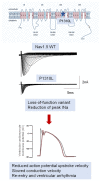Brugada Syndrome: More than a Monogenic Channelopathy
- PMID: 37626795
- PMCID: PMC10452102
- DOI: 10.3390/biomedicines11082297
Brugada Syndrome: More than a Monogenic Channelopathy
Abstract
Brugada syndrome (BrS) is an inherited cardiac channelopathy first diagnosed in 1992 but still considered a challenging disease in terms of diagnosis, arrhythmia risk prediction, pathophysiology and management. Despite about 20% of individuals carrying pathogenic variants in the SCN5A gene, the identification of a polygenic origin for BrS and the potential role of common genetic variants provide the basis for applying polygenic risk scores for individual risk prediction. The pathophysiological mechanisms are still unclear, and the initial thinking of this syndrome as a primary electrical disease is evolving towards a partly structural disease. This review focuses on the main scientific advancements in the identification of biomarkers for diagnosis, risk stratification, pathophysiology and therapy of BrS. A comprehensive model that integrates clinical and genetic factors, comorbidities, age and gender, and perhaps environmental influences may provide the opportunity to enhance patients' quality of life and improve the therapeutic approach.
Keywords: Brugada syndrome; Nav1.5; SCN5A; arrhythmia; cardiac channelopathy.
Conflict of interest statement
The authors declare no conflict of interest.
Figures
Similar articles
-
Complex genetic background in a large family with Brugada syndrome.Physiol Rep. 2015 Jan 27;3(1):e12256. doi: 10.14814/phy2.12256. Print 2015 Jan 1. Physiol Rep. 2015. PMID: 25626866 Free PMC article.
-
Diagnostic yield and variant reassessment in the genes encoding Nav1.5 channel in Russian patients with Brugada syndrome.Front Pharmacol. 2022 Aug 24;13:984299. doi: 10.3389/fphar.2022.984299. eCollection 2022. Front Pharmacol. 2022. PMID: 36091819 Free PMC article.
-
Single-cell transcriptomics trajectory and molecular convergence of clinically relevant mutations in Brugada syndrome.Am J Physiol Heart Circ Physiol. 2021 May 1;320(5):H1935-H1948. doi: 10.1152/ajpheart.00061.2021. Epub 2021 Apr 2. Am J Physiol Heart Circ Physiol. 2021. PMID: 33797273
-
Brugada Syndrome: From Molecular Mechanisms and Genetics to Risk Stratification.Int J Mol Sci. 2023 Feb 7;24(4):3328. doi: 10.3390/ijms24043328. Int J Mol Sci. 2023. PMID: 36834739 Free PMC article. Review.
-
Brugada Syndrome: Oligogenic or Mendelian Disease?Int J Mol Sci. 2020 Mar 1;21(5):1687. doi: 10.3390/ijms21051687. Int J Mol Sci. 2020. PMID: 32121523 Free PMC article. Review.
Cited by
-
Zebrafish as a Model System for Brugada Syndrome.Rev Cardiovasc Med. 2024 Sep 5;25(9):313. doi: 10.31083/j.rcm2509313. eCollection 2024 Sep. Rev Cardiovasc Med. 2024. PMID: 39355588 Free PMC article. Review.
-
Primary Electrical Heart Disease-Principles of Pathophysiology and Genetics.Int J Mol Sci. 2024 Feb 2;25(3):1826. doi: 10.3390/ijms25031826. Int J Mol Sci. 2024. PMID: 38339103 Free PMC article. Review.
-
Cardiomyopathy: pathogenesis and therapeutic interventions.MedComm (2020). 2024 Oct 25;5(11):e772. doi: 10.1002/mco2.772. eCollection 2024 Nov. MedComm (2020). 2024. PMID: 39465141 Free PMC article. Review.
References
-
- Priori S.G., Blomström-Lundqvist C., Mazzanti A., Blom N., Borggrefe M., Camm J., Elliott P.M., Fitzsimons D., Hatala R., Hindricks G., et al. 2015 ESC Guidelines for the management of patients with ventricular arrhythmias and the prevention of sudden cardiac death: The Task Force for the Management of Patients with Ventricular Arrhythmias and the Prevention of Sudden Cardiac Death of the European Society of Cardiology (ESC). Endorsed by: Association for European Paediatric and Congenital Cardiology (AEPC) Eur. Heart J. 2015;36:2793–2867. doi: 10.1093/eurheartj/ehv316. - DOI - PubMed
Publication types
Grants and funding
LinkOut - more resources
Full Text Sources
Miscellaneous



